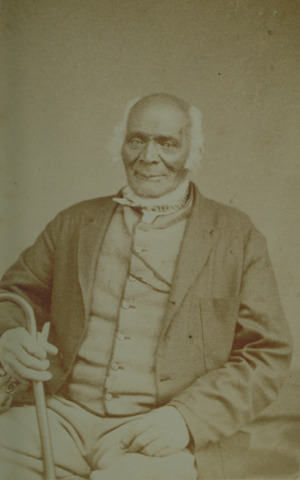James Mars facts for kids
Quick facts for kids
James Mars
|
|
|---|---|

Mars in 1870
|
|
| Born | March 3, 1790 Canaan, Connecticut, US |
| Died | May 27, 1880 (aged 90) Ashley Falls, Massachusetts, US |
| Language | English |
| Subject | Autobiography, slave narrative |
| Notable works | A Life of James Mars, a Slave Born and Sold in Connecticut |
James Mars (born March 3, 1790 – died May 27, 1880) was an American writer and activist. He was born into slavery in Canaan, Connecticut. James Mars became free in 1811.
In 1864, he wrote a book about his life called A Life of James Mars, a Slave Born and Sold in Connecticut, Written by Himself. This book is an important example of a slave narrative, which tells the stories of people who were enslaved. Today, his grave is part of the Connecticut Freedom Trail. In 2021, the Governor of Connecticut, Ned Lamont, even made May 1 "James Mars Day" in the state.
Contents
James Mars's Early Life and Freedom
James Mars was born into slavery in Canaan, Connecticut. His parents, Jupiter and Fanny Mars, were also enslaved. They were owned by Reverend Amos Thompson, a church minister, and his wife. Jupiter Mars fought in the American Revolution. James's sister, Elizabeth, later spent 34 years working as a missionary in Liberia.
In 1784, Connecticut passed a law to slowly end slavery. This law said that anyone born into slavery in Connecticut on or after March 1, 1784, would become free when they turned 25. For James, this meant he should be free at age 25.
However, Reverend Thompson tried to avoid this law. He planned to move James and his family to Virginia, which was a slave state where slavery was still allowed. But the Mars family escaped to nearby Norfolk, Connecticut. There, people who were against slavery helped them. They kept the family hidden and safe from Thompson and his helpers who tried to catch them.
By 1798, Thompson made a deal with the Mars family. James and his brother agreed to work as enslaved people in Norfolk until they turned 25. In return, their parents and sister became free right away. James's new owner, Mr. Munger, was very strict. In 1811, James Mars paid $90 to buy his freedom. Later, he even took care of Mr. Munger and his daughter when they were sick.
James Mars: A Leader for Change
After gaining his freedom, James Mars became a leader in the community of free African Americans in New England. He worked to help other Black people. He also supported movements for temperance (reducing alcohol use) and for the right to vote (called enfranchisement).
In the 1830s, Mars worked in a store in Hartford, Connecticut. He helped start the Talcott Street Church. He served as a deacon there, working with minister James W. C. Pennington.
Mars was also important in a famous court case in 1837 called Jackson v. Bulloch. In this case, the Connecticut Supreme Court decided that a woman named Nancy Jackson, who had escaped slavery, should be free. She had lived in Connecticut for two years with her owner from Georgia. Mars also helped raise money to pay for the lawyers who defended the people on the La Amistad ship. By 1840, he was on the board of the Connecticut Anti-Slavery Society, which worked to end slavery.
James Mars's Later Years
James Mars got married in the early 1830s. He and his wife had eight children, but one died when it was a baby. Around 1845, his family moved to Pittsfield, Massachusetts. He lived there for twenty years, bought land, farmed, and kept working for Black rights and against slavery. Three of his sons fought for the Union in the Civil War.
When he was an older man and didn't have much money, Mars returned to Norfolk. In 1864, he published his book, The Life of James Mars: A Slave Bought and Sold in Connecticut. This short book was printed many times. In 1868, a new edition came out with more details about his later life. Mars explained that he wrote his story because "some told me that they did not know that slavery was ever allowed in Connecticut."
In August 1879, the State of Connecticut gave Mars a pension, which is like a regular payment for older people. He died less than a year later in Ashley Falls, Massachusetts. He was buried in the Center Cemetery in Norfolk.
Images for kids


